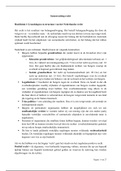Summary
Summary - Correlational Research Methods (424527-B-5)
- Course
- Institution
This is a detailed summary of the Correlational Research Methods course. It includes notes from the slides together with extra explanations from the book and tutorials.
[Show more]








